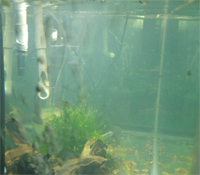| |
Select
Aquatics of Erie, CO |
|
|
|
|
|
|
|
|
|
|
|
|
| |
A common problem,
The Cloudy
Tank |
 |
|
|
| |
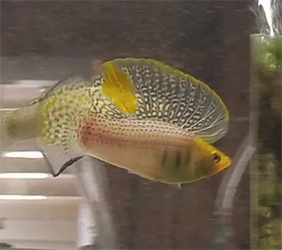 |
|
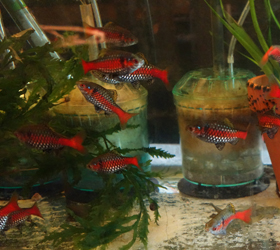 |
|
The goals
for any fish tank are simple:
Healthy fish that are happy, unstressed,
at best color, growing their fastest rate
and breeding when conditions are right.
That can only happens when you
set up
the tank and care for it thinking of the
fish first- your desires come only after
their needs are met! |
 |
|
|
|
Introduction
It is rare
to keep your tanks in such consistent condition that you never
run into problems with the overall
health of your fish.
Equipment malfunctions, even normal growth
can eventually lead to water quality adjustments and
opportunities for disease to
develop. At the
fishroom here, much time is spent maintaining tanks to avoid
invitations to disease and deteriorating conditions,
but problems will still occur, and when
that happens, being prepared and knowing what to do are
improtant. .
These
next three sections were put together in response to email
conversations with customers that obtained fish, and the
issues are arranged as you might
encounter them, but possibly not in a way a book may address
them. For example, you may
find a recommendation in a text for
treating "cloudy water", but dealing with water that is yellow
or brown may signal certain things
going on in your aquarium that a fish book may not address. As well, answers to basic
questions never never seem to be answered,
such as
"How
long does a fish live?",
"How long, really, can a fish go
without food" or without filtration
or aeration in case the power
goes out - These are
some of the questions covered in these next sections.
|
 |
|
|
| |
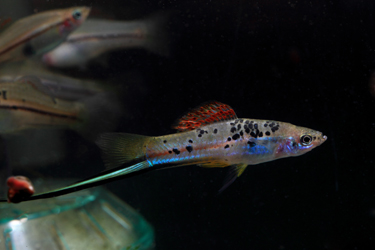 |
|
The
Xiphophorus helleri, Rio
Otapa swordtail is possibly
the prettiest wild swordtail, while also being one of
the
largest, where occasional males will surpass 6 inches.
Males can show a variety of appearances, some
will have black spotting, but all have the fiery red
dorsal. It is also a very hardy fish that is easy to
maintain, and prolific with few demands beyond
consistent water quality, aeration and quality
food. |
 |
|
|
|
Disease preventatives are available and can
be used, but fish here are raised so they will do best after
arriving in customers' tanks.
Most people do not use those types of
products, so safeguards such as the use of
salt are used only
when necessary. Diseases
are rare with consistent, appropriate
maintenance, and are quickly dealt with here in an established manner. I
will share that routine
with you so that when the rare sign of
disease presents itself, you can approach the problem
deliberately and with some confidence.
Treating
unexpected incidents is as much an art as a science, and the
next 3 sections
"The Fish",
"The Tank", and
"Diseases" are
a best effort attempt to share the actions and
treatments followed here when something occurs, but every home
aquarium setup is
slightly different. Ideally, these next
pages will help to develop a mindset that leads to a comfortable
understanding of your tank,
why problems may occur, and how your fish will
likely respond to various treatments.
These next
sections are not a large collection of medications, dosages, and
actions that must be done in each specific
circumstance, as many
books on
disease can be.
The reality is that the majority of incidents fall into 4 or 5
disease types that are
most common in our home aquariums. Knowing
how to address them solves the problem when it appears, and also
provides
insight to dealing with rarer problems when they
come your way. Of course, simple prevention through routine,
effective maintenance
is the best safeguard against disease. But when something does occur,
learn from it, and use the experience to attempt to prevent
it from happening again.
|
 |
|
|
| |
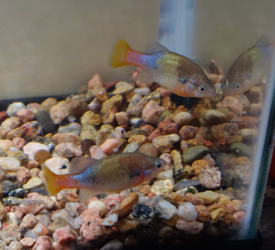 |
|
These Xenotoca
eiseni, San Marcos, are one of the hardiest
goodeids
that can be kept, and certainly the prettiest. They can
tolerate into the
high 70s, will thrive in the high 60s, most comfortable
at 72-75 degrees.
They are also prolific and the young are easy to
raise, but they tend to
do best when kept in a tank by themselves.
|
 |
|
|
|
When
keeping uncrowded tanks with
consistent care and
temperature, regular
water changes, minimal or relatively
clean substrate,
aeration, adequate
filtration and
quality
food, you should experience long
periods without incidents of
disease.
Each day here, before any work starts, a
walkthrough is done to briefly observe each tank and get a
handle on the current
condition of the room. A friend who has
owned a fish store for many years has said he can stand in the
doorway of his shop
overlooking his tanks, and with just a brief glance can sense immediately
which tanks are having issues.
I will try to address each circumstance you
might see on a similar walkthrough of your
fishroom, what to
look for, and when
something is seen, what is done here to
best address it. This information refers to fresh water only.
Though I have been a
devoted hobbyist for many years, I am not a
vet, and will not give advice on issues I have not dealt with
personally.
This information is not meant to be the
last word on anything - I am simply sharing our experience.
Having a good book nearby
on
diseases is
essential, as there are many things that can occur in an
aquarium, some you may experience that we do not
as a result of different water qualities,
or
climate and critters in your area. |
 |
|
|
| |
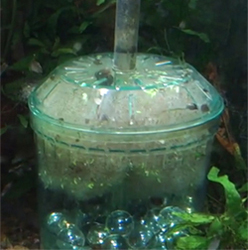 |
When
looking for a filter for your
aquarium you have many choices based on
the time you have to do
maintenance, and how much money
you want to spend.
Most filters recommended for the size tank you have
will do fine, as long as they
are a filter that actively removes
the organic waste and debris that will collect in
the aquarium. Using sponge
based filters as the sole source of filtration will work,
but there is much more
work required on your part to keep both the tank bottom
and sponge clean enough so the fish
will do well. Some species will appear to do
well when the fitration is inadequate, but size, color
and breeding may not be what
they should, as well as inviting episodes of disease.
Here, we go with simple, effective and inexpensive.
Durable box filters with no
moving
parts or airstones that have been the standard for
specialty breeders since the 1960s.
They are filled with polyester floss found
at any hobby store, changed monthly, with
marbles to weigh them down. In combination with a
relatively clean tank and
consistent, routine
water changes,
diseases are rare. |
 |
|
|
|
Many
disease or
water maintenance
problems can be first addressed with an immediate 40-50%
water change,
cleaning
the
filter medium, and
thoroughly siphon cleaning any substrate.
Then, if it appears to be a minor
disease issue, you may
choose to add a
medicinal dose of salt
to the aquarium (1 tablespoon per every 5 gallons of
water), which for many
things will stop the infection and give you
time to determine whether further medication is necessary. I
will deal with each
issue in the upcoming sections. You would
then gradually remove the salt through weekly water
changes. All treatments
come with consequences, and salt will
negatively affect many types of plants.
Most issues, either directly or indirectly,
can be traced to water quality, As soon as you notice a
problem, you will want
to best determine what you think is going
on, then whether a medication will be necessary. Then perform
the tank "reboot",
(doing what was mentioned above), followed
by the appropriate medication, if necessary, following the
manufacturer's
recommendations.
Some feel that scaleless fishes do not
respond as well to the use of salt, and I cannot speak to that.
However, there has never
been a problem using salt with the Livebearers,
Cichlids or the Pleco Catfish bred and raised here. Using salt,
however, like
any medication, has side effects, so
avoiding disease in the first place
through appropriate
husbandry is always the best route.
When a specific fish is experiencing an
issue, and it is not contagious, you should isolate it from the
population, providing
individual care and medication when necessary.
When dealing with a diseased tank, use only nets and equipment
that have
been dedicated to that tank. This
includes washing your hands between tanks when dealing with a
disease, or it could be
spread throughout your
room!
These
next sections are simply an effort to share the problems and
solutions shared by customers, as well as my own effort to
list issues and actions that are taken
here. If you have any comments, or would like to see something
included that has not
been addressed, please email me at
selectaquatics@gmail.com, and I look forward to
hearing from you - Thank you!
Greg Sage
selectaquatics.com
selectaquatics@gmail.com
|
 |
|
|
|
|
|
|
|
|
|
|
|
|
|
|
|
|
|
|
|
|
